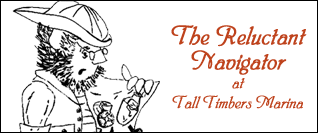Commentary by Tom Horton
It's a chilly afternoon when the miracle of the fishes happens at the sleepy port of Chestertown on Maryland's upper Eastern Shore.
Hardly anyone's there to notice when Robbie Joiner docks his mud-streaked skiff among fine pleasure boats and begins offloading close to a ton of fat, glistening fish.
"People are amazed when they see us," Joiner says. "They can't believe all that came out of the Chester River."
But it does, from days in January that are so cold that the catch freezes solid in the open skiff to a spring so pretty you think you could be a waterman too.
From fyke nets, an ancient design of fish trap, set along the river's edges, Joiner and his son Mike routinely bring to the dock enough fresh, tasty protein to feed all of Chestertown.
Chesapeake watermen these days seem to mostly make the news for bad things - illegal oystering last fall, and illegal rockfish nets this spring.
Watermen aren't saints. Making a living from the wild, with little of the safety net or job security most of us enjoy, disposes one to make hay while the sun shines, to push the limit.
But spend a day on the river with the Joiners, and it seems little short of miraculous that a handful of the Bay region's 17 million citizens persist in wresting a living from nature in the face of stubborn pollution, growing regulation and overwhelming competition from sportsmen for fish and waterfront access.
Robbie and Mike catch the mouth of the first fyke with a boat hook and swing it smoothly across the skiff's flat bow. Grasping the first and largest of several Fiberglas hoops joined by netting into a long cone, Mike works the catch into a slithering, splashing solid mass at one end of the fyke. Robbie simultaneously maneuvers over submerged stumps, holding position against wind and tide. They make it look easy, but just try it. You'll find the net around your propeller so tight you have to call for a tow. Don't ask me how I know.
Wielding a big dip net, Mike ladles fish from the fyke onto a wooden sorting table. Into one crate Robbie flips mud shad, dully lustrous slab-sided fish, sold cheap for bait. Delicious eating white perch, flashing silver with brilliant blue highlights along their upper bodies, go into others.
The Joiners' deckhand, Marc Castelli, says most people never see the vibrant colors in seafood fresh from Bay waters - tints and glints and iridescences that fade quickly. Castelli is also one of the finest artists painting the Chesapeake scene. He spends countless hours on watermen's boats photographing and working the decks.
To paint "white" perch accurately, he must mix "some blues that are so bright you'd never think you'd use them. But that's what you need," Castelli says.
The real jewels the river offers up today are the yellow perch, early spawners who begin massing up Bay tributaries when the water is just 10 degrees above freezing. Their bright, red-orange fins glow against creamy bellies. Bands of lemony gold and olive and bronze shade light to dark laterally along their small, plump bodies, which also shade from belly to backbone. Every scale contains variations of all these colors: "I'm still working up the courage to paint them," Castelli says.
The "yellow neds" are in short supply today, to Joiner's disappointment. They fetch $2-$3 a pound - some of the Bay's highest value seafood.
Worse, when he gets one longer than 11.5 inches, Joiner must toss it back: "for the tourists."
The state, under pressure from sportfishermen, recently installed a strict quota system on yellow perch. It requires watermen to release the big female spawners and account to fisheries managers each day by phone for each perch landed. Similar, tightened restrictions also apply to blue crabs, striped bass and oysters.
"I got a feeling the sportfishermen are going to want it all," Joiner says.
The good side, according to Maryland Department of Natural Resources experts, is that the fishery in the Chester is healthy and sustainable.
Back at the dock, Joiner has several hundred pounds of perch, mostly white. White perch was once regarded as fine eating, he says. It tastes as good as ever. "But people today don't know how to clean or cook a whole fish. If you can't unwrap the cellophane and microwave it...."
I pick out a couple of jumbo white perch for my dinner. Joiner won't take money. It takes about five minutes to gut, scale and behead the pair, and about 15 minutes to fry them up crisp and golden, so the firm meat slips off the bones at fork's touch.
Fresh seafood is always something special; but fresh seafood from fishermen and waters you know is as good as it gets.
Tom Horton covered the bay for 33 years for The Sun in Baltimore, and is author of six books about the Chesapeake. He is currently a freelance writer. Distributed by Bay Journal News Service.


